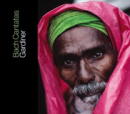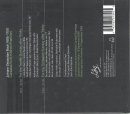|
|
John Eliot Gardiner & Monteverdi Choir & English Baroque Soloists
Bach Cantata Pilgrimage - Vol. 6
|
|
P-6 |
Bach Cantatas Vol. 6: Köthen/Frankfurt
For the 12th Sunday after Trinity
For the 13th Sunday after Trinity |



|
|
CD-1: Cantatas BWV 69a [17:18], BWV 35 [24:32], BWV 137 [12:49]
CD-2: Cantatas BWV 77 [17:47], BWV 164 [16:16], BWV 33 [22:42] |
|
John Eliot Gardiner |
|
Monteverdi Choir / English Baroque Soloists |
|
CD-1: Soprano: Katharine Fuge, Counter-tenor: Robin Tyson; Tenor: Christoph Genz; Bass: Peter Harvey
CD-2: Soprano: Gillian Keith; Alto: Nathalie Stutzmann; Tenor: Christoph Genz; Bass: Jonathan Brown |
|
Soli Deo Gloria 134 |
CD-1: Sep 10, 2000
CD-2: Sep 17, 2000 |
2-CD / TT: 108:56 |
|
Live recordings from the Bach Cantata Pilgrimage:
CD-1: Jakobskirche, Köthen, Germany.
CD-2: Dreikönigskirche, Frankfurt, Germany.
See: John Eliot Gardiner - Bach Cantata Pilgrimage - Vol. 6
Buy this album at:
2-CD: Amazon.com | Amazon.co.uk | Amazon.de
Music Download: Amazon.com | ClassicsOnline |
|
Gardiner hits another one out of the park |
|
Kayak wrote (September 23, 2007):
Sample track released Sept 10, 2007. BWV 77/1.
First performed August 22, 1723
http://www.monteverdiproductions.co.uk/realaudio/134_2_1.ram
Definitely the best recording of this opening chorus. You can almost hear Bach delicately tip-toeing past every moment that threatens to descend into Baroque cliches. The compositional mastery is matched step for step by this superbly detailed rendition.
Gardiner comments;
"Here is one of those breathtaking, monumental opening choruses that defy rational explanation: how an over-worked, jobbing church musician, locked into numbing routines, could have come up with anything so prodigious and not, as we have seen, in an isolated work, but as part of a coherent cycle of weekly works. Bach aims to demonstrate by means of every musical device available to him the centrality of the two 'great' commandments of the New Testament and how 'on these two commandments hang all the law and the prophets'. So he constructs a huge chorale fantasia in which the chorus, preceded by the upper three string lines in imitation, spell out the New Testament statement, their utterances encased in a wordless chorale tune that would have been associated in the minds of all his listeners with Luther's Ten Commandments hymn. This appears in canon, a potent symbol of the law, between the tromba da tirarsi at the top of the ensemble and the continuo at its base, a graphic device to demonstrate that the Old Testament serves as the bedrock of the New, or, expressed differently, that the entire Law is understood to frame, and be inseparable from, Jesus' commandments to love God and one's neighbour.
But that is only just the start. Bach extrapolates the vocal lines from the chorale theme, so that they emerge audibly as a retrograde inversion of the chorale tune in diminution. Imagine it as a giant Caucasian kilim, with the geometric design and decorative patterning all of a piece. Your eye is drawn first to the elegant weave of the choral lines, but you then begin to discern a broader outline: the same basic design, but on a far bigger scale, one twice the size of the other, and bordering the whole. That is the canon in augmentation, the bass line proceeding at the lower fifth at half speed (in minims), symbol of the fundamental law. Bach's construct allows the trumpet (in crotchets) to deliver nine individual phrases of the chorale and symbolically, in a tenth, to repeat the entire tune for good measure so that at the climax of the movement the 'old' and the 'new' are unambiguously fused in the listener's mind. The tune itself, at least thirteenth-century in origin, began as a pilgrimage hymn to the words 'In Gottes Namen fahren wir', selected by Luther, or those close to him, as an appeal to God for protection - particularly at the start of a sea voyage in which Christ was the chosen captain or pilot. Other than Ein feste Burg (BWV 80), no other canonic treatment of a cantus firmus we've met so far
has quite the same air of monumentality or hieratic authority as this.
The strange thing is that whenever the chorale tune stops, and even before it first gets going, the music reveals a searching, almost fragile quality. Soon you notice that Bach has left out the normal 8' continuo from the opening ritornello (instead the violas have a figured bassettchen bass line) and a huge chasm in pitch, structure and dynamics opens up between the gentle interweaving of the imitative contrapuntal lines (presumably for strings only, though in the absence of the original parts we cannot be sure of this as none of the instruments is specified in the autograph score other than the tromba part) and the full, impressive weight of the double canon. The choral voices thunder out 'Thou shalt love the Lord thy God' like so many evangelising sculptors chiselling the words into the musical rock face. One now realises that this emphasis on height and depth is being presented as a spatial metaphor for the divine and human spheres: distant, yet interconnected. Bach builds up colossal tension as a result of this dramatic textural alternation, the voices presumably dropping to piano whenever the trumpet/bass dialogue pauses for breath. Rightly or wrongly, I took it that the three oboes, whose presence elsewhere in the cantata makes it unlikely that they would have been excluded from the first movement, should double the voice lines only when the trumpet/bass themes are present.
The whole edifice lends itself to allegorical interpretation beyond the obvious meshing of Old and New Testament commandments, the former strict in its canonic treatment, the latter freer and more human in its choral working out, and the symbolic separation of God's control of the spheres of 'above' and 'below' (five statements of each, making ten in all). As Martin Petzoldt has shown, their moments of intersection point to the 'concord' or 'Übereinstimmung' willed by God for community with humankind and his promise of mercy to those who keep his commandments. To this, Eric Chafe (who devotes two whole chapters to this work) points to the anomalous flattened pitches in the mixolydian version of the chorale tune which 'inspired Bach to emphasise the sub-dominant minor' at the climax of the movement (bar 58), 'the point at which the trumpet reaches its highest tone and the rhythmic activity of the chorus is at its greatest. Its role in the allegorical design for the movement is to create a subdominant/ minor region from which the restoration of G emerges at the last possible moment in conjunction with the insight that love of God and love of one's neighbour as oneself are inseparable.' If this analysis seems a little dry - and it is certainly accurate - the music at this point is stupendous, the voices first in downward then in upward pursuit under the canopy of the trumpet's final blast of the chorale and cadencing over the solid G pedal of the bass. Chafe makes great play with the alternation of F natural and F sharp in the trumpet part four and five bars before the end (apparently there were different versions of the tune current in his time that Bach may have been quoting). The symbolic uncertainty they represent when associated with the injunction to 'love thy neighbour as thyself' suggests that without God's help we adoomed to failure. The end result is a potent mixture of modal and diatonic harmonies, one which leaves an unforgettable impression in the mind's ear, and in context propels one forward to the world of Brahms' German Requiem and beyond, to Messiaen's Quartet for the End of Time." |
| |
|
John Eliot Gardiner :
Short Biography
Ensembles:
Monteverdi Choir
| English Baroque Soloists
Bach Discography: Recordings of Vocal Works:
Part 1
| Part 2
| Part 3
| Part 4
| Part 5
| Part 6
| Videos
| Recordings of Instrumental Works
Table of recordings by BWV Number
General Discussions:
Part 1
| Part 2
| Part 3
| Part 4
| Part 5
| Part 6
| Part 7
| Part 8
| Part 9
| Part 10
| Part 11
| Part 12
| Part 13
| Part 14
| Newsletters
Discussions of Cantatas:
Cantatas BWV 106, 118b, 198
| Cantatas BWV 140, 147
| Cantatas BWV 11, 37, 43, 128
| Cantatas BWV 6, 66
| Cantatas BWV 72, 73, 111, 156
| Cantatas BWV 82, 83, 125, 200
Discussions of Bach Cantata Pilgrimage:
BCP - Vols 1&8
| BCP - Vol. 6
| BCP - Vol. 9
| BCP - Vol. 13
| BCP - Vol. 14
| BCP - Vol. 15
| BCP - Vol. 21
| BCP - Vol. 22
| BCP - Vol. 23
| BCP - Vol. 24
| BCP - Vol. 26
| Bach Cantata Pilgrimage DVD
| DVD John Eliot Gardiner in Rehearsal
Discussions of Other Vocal Works:
BWV 232 - J.E. Gardiner
| BWV 244 - J.E. Gardiner
| BWV 245 - J.E. Gardiner
| BWV 248 - J.E. Gardiner
| BWV 1127 - J.E. Gardiner
Bach Festivals and Cantata Series:
Bach Cantata Pilgrimage
Books:
Bach: Music in the Castle of Heaven
|
|
|